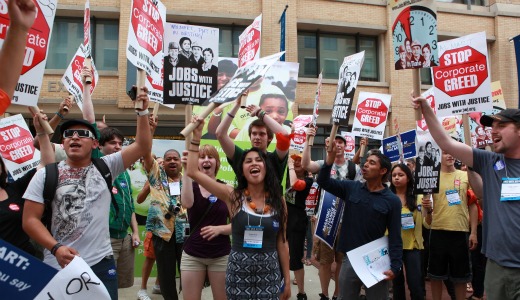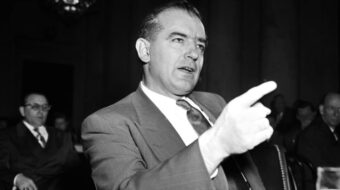
President Obama announced yesterday, Oct. 26, that his administration will authorize a series of student loan initiatives to help borrowers better manage their student debt with less financial strain after they graduate. Student activists say the president’s executive order on the issue is a good first step, but is not nearly enough to tackle the larger student debt crisis.
“We need systematic changes in how we pay for our education because it’s just not affordable,” said Chris Hicks, national coordinator with the Student Labor Action Project. “It’s great that Obama is taking some good first steps, but it’s too little, too late.”
Hicks notes the current economic crisis and the lack of jobs across the nation has taken a particularly heavy burden on students. The unemployment rate among youth is nearly 20 percent, he said, and too many college graduates are being forced to take unexpected career paths to make ends meet. Last year the average debt for a college grad was $25,000, said Hicks. Six months after graduation students are stuck with credit collectors requesting loan payments, he said.
“Students are graduating off a cliff with a mountain of loan debt in a time where jobs are scarce,” said Hicks. Some are forced to consider bankruptcy, he said.
Hicks mentioned his middle school friend, a recent college graduate with a degree in economics, and his struggle finding a job. “Now he’s a grocery bagger.”
Hicks said the Occupy Wall Street protests sweeping cities across the country have cited rising student debt crisis as one of the movements main concerns.
“The occupy movement is a wake-up call. Education is a right and everyone should have access to go to college. But we’ve moved away from that idea. It’s harder to get financial aid, funding for higher education is being slashed and state budget cuts and rising tuition rates are not helping.”
Hicks continued, “The country was derailed by corporate greed and that’s why people are willing to occupy their cities and sleep in parks. Enough is enough! Our country is moving in the wrong direction and it’s time we fix it.”
For Hicks, Obama’s student loan relief plan is the first real victory based on the demands of the occupy Wall Street movement. He believes the pressure and leadership by students and youth and their allies in the occupy movement was what pushed the Obama administration to act on the loan debt crisis.
Officials in the Obama administration have admitted the president’s student loan debt relief plan was spurred in part by a petition on the White House website, signed by 30,000 people, calling for reform.
Speaking to thousands of students at the University of Colorado’s Denver campus, Obama said he will no longer wait on Congress to respond to the rising financial burden of higher education.
“Student loan debt has now surpassed credit card debt for the first time ever,” said Obama. “And when a big chunk of every paycheck goes towards student loans instead of being spent on other things, that’s not just tough for middle-class families, it’s painful for the economy ands it’s harmful to our recovery because that money is not going to help businesses grow.”
Obama said his plan has the potential to boost the economy.
Under the new measure students graduating with unmanageable levels of student debt could have their monthly payments capped to what they can afford through the Income Based Repayment (IBR) program. Beginning July 1, 2014, the IBR plan is scheduled to lower that limit from 15 percent to 10 percent of discretionary income while the remaining balance is forgiven after 20 years rather than 25 years.
Another aspect is the “pay as you earn” option, which could benefit up to 1.6 million low-income borrowers and reduce their payments by as much as a couple of hundred dollars a month.
Other initiatives include a special consolidation plan to make payments easier and help students lower their interest rates, save money, and simplify the process. The plan also aims to share clear and easy to understand information on financial aid forms to help students and their families better comprehend their financial aid package and the cost of college.
“The president’s student loan initiative is a positive move in an effort to curtail and fight back against the epidemic student debt has become,” said Victor Sanchez, president of the United States Student Association, in a statement.
“While some borrowers straddled with tens of thousands in student debt may not qualify for some or any of the benefits outlined in Obama’s new student loan initiatives, the action by the administration is a step in the right direction,” said Sanchez.
He notes more immediate relief is still needed.
“Undoubtedly though, this reflects a shift in the national political dialogue in part as a result of the frustration expressed by the young people in the occupy movement decrying unmanageable student debt in an economy with no jobs,” said Sanchez. “We remain confident that more is to come and support these initial strides towards providing relief for student loan borrowers.”
To read the president’s plan in detail click here. Photo: Courtesy of the Student Labor Action Project’s Facebook page.










